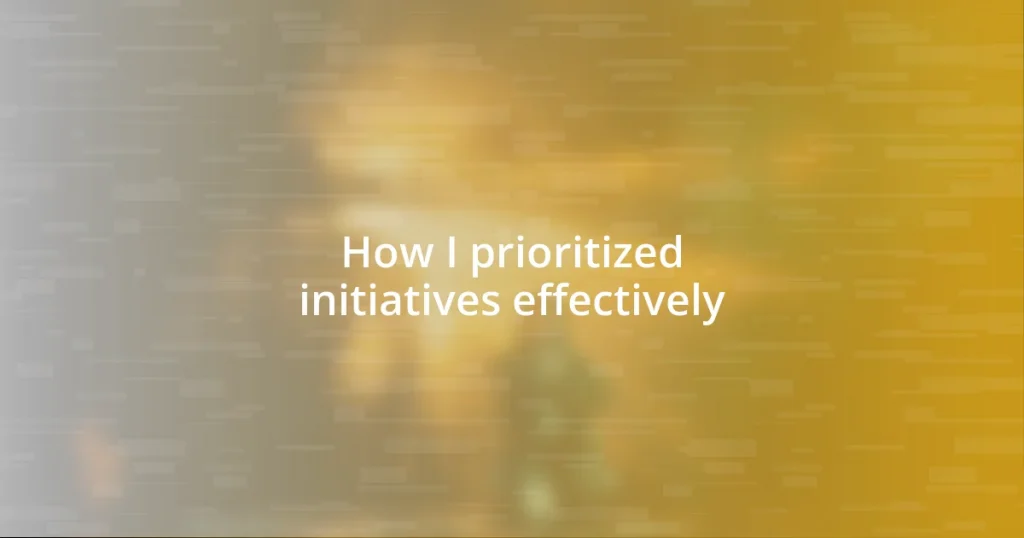Key takeaways:
- Effective prioritization requires alignment with long-term goals, clarity in objectives, and collaborative decision-making.
- Utilizing prioritization frameworks, such as the Eisenhower Matrix and MoSCoW method, enhances focus and decision-making in project management.
- Regularly reviewing and adjusting priorities based on feedback and evolving circumstances is crucial for maintaining relevance and driving impactful outcomes.

Understanding initiative prioritization processes
Understanding initiative prioritization processes begins with recognizing that not every idea holds the same weight. I remember an instance where I was overwhelmed by multiple projects at once. It was then I realized that clarity in goals is not just helpful—it’s essential.
When I think about prioritization, I often ask myself: What truly drives value? In one project, I found myself juggling initiatives that seemed important but didn’t align with our overarching vision. This taught me that evaluating the alignment with long-term goals is crucial. It’s not just about what’s urgent but what’s impactful.
I’ve also learned that collaboration plays a vital role in effective prioritization. Involving team members in the decision-making process can bring fresh perspectives and uncover insights I might have overlooked. Have you ever considered how much richer the prioritization process can be when shared? It’s a game-changer.

Assessing goals and objectives clearly
Assessing goals and objectives clearly starts with a comprehensive understanding of what we aim to achieve. I vividly recall a project where our team set ambitious targets without fully dissecting each objective. It was only after a candid discussion that we realized some of our goals were too vague or overlapping. This reflection helped us hone in on clear, measurable objectives—making it easier to gauge progress and adapt.
When I assess goals, I often create a simple checklist to identify clarity and relevance. For example, does a goal directly contribute to our broader mission? In one case, I had a goal that seemed essential, but further analysis revealed it was merely a distraction from more impactful initiatives. This experience underscored the importance of continuous reassessment; clarity is not a one-time task but an ongoing commitment.
I also like to visualize goals through comparison tables. They provide a straightforward snapshot of purpose versus execution. Comparing goals side-by-side allows me to prioritize initiatives effectively, maintaining a focus on those that drive genuine value. Let’s look at the comparison below.
| Goal | Clarity & Relevance |
|---|---|
| Increase social media engagement | Clear, measurable |
| Launch new product line | Ambiguous, requires further definition |

Identifying resources and constraints
Identifying resources and constraints is an essential aspect of effective prioritization. I can’t emphasize enough how important it is to take stock of what you have and what you don’t. I once jumped into a project with high hopes, only to be met with a lack of key personnel and budget limitations. That’s when I realized that resources—be it time, talent, or finances—constantly shape what you can realistically achieve. Identifying these elements at the outset can save a lot of frustration down the line.
- Human Resources: Assessing the skills and availability of team members.
- Financial Resources: Understanding the budget constraints for each initiative.
- Time Constraints: Evaluating project timelines and deadlines.
- Technical Resources: Identifying necessary tools, technology, or platforms.
- Knowledge Gaps: Recognizing where additional training or information is needed.
I’ve found that mapping out these resources allows me to anticipate potential challenges right away. In one instance, I gathered my team for a brainstorming session to openly discuss each person’s workload and skills. This collaborative approach revealed hidden strengths and gaps. It was a revelation that transformed how we approached the project. It’s amazing how clear visibility into resources can create a shared sense of ownership and responsibility, turning constraints into stepping stones for innovation.

Evaluating potential impacts thoroughly
Evaluating potential impacts thoroughly is critical to ensuring that our initiatives lead to meaningful outcomes. I recall a time when our team faced several project proposals, each promising great benefits. Yet, a deep dive into potential impacts allowed us to see that one project, initially appealing, was likely to overwhelm our current capabilities and stretch our resources thin. This experience taught me the value of engaging in a thorough impact analysis, often using scenarios to visualize outcomes based on different variables.
A practical approach I employ involves creating impact matrices. This helps to not only assess the anticipated benefits but also examine potential risks and downsides. I vividly remember a project where we evaluated the effects of a new marketing strategy. By mapping out outcomes—like increased brand visibility versus potential customer backlash—we could better weigh our options. It felt enlightening to lay all the possibilities on the table—how often do we overlook the downsides in our enthusiasm?
Finally, asking the tough questions sometimes makes all the difference. How will our stakeholders respond to this initiative? Are we ready to handle any unintended consequences? Reflecting on past initiatives, I clearly remember a campaign that backfired due to insufficient audience research. Narrowing our focus on potential impacts in advance could have saved us from that costly misstep. Trust me, honing in on these considerations not only empowers better decision-making but helps sustain our enthusiasm throughout the project lifecycle.

Using prioritization frameworks effectively
Using prioritization frameworks effectively means knowing which tools can sharpen focus and streamline decision-making. One framework I’ve found particularly helpful is the Eisenhower Matrix, which categorizes tasks based on urgency and importance. There was a time when I felt overwhelmed by my to-do list. But once I started sorting tasks this way, the fog of indecision started to clear—suddenly, the essentials jumped out, and I could see exactly what needed attention first. Have you ever experienced that rush of clarity when you finally clarify your priorities? It’s incredibly empowering.
Another framework I often rely on is the MoSCoW method, which distinguishes between Must-haves, Should-haves, Could-haves, and Won’t-haves for a given project. I remember using this during a strategic planning session where conflicting ideas seemed to swirl in chaos. By applying the MoSCoW method, we collectively identified our non-negotiables. It was like flipping a switch; priorities became tangible, and everyone was aligned. Isn’t it amazing how a structured approach can transform discussions into action?
Finally, the Value vs. Effort matrix stands out as a simple yet powerful tool. I once led a team that was split on whether to invest resources in an extensive upgrade or a quick fix. Using this matrix, we mapped out the estimated value of each option against the effort required. Surprisingly, the quick fix offered substantial value for minimal effort, and I remember the relief when we realized we could make quick gains without exhausting our resources. Have you ever found an unexpected solution just by evaluating options differently? It’s moments like these that reinforce the importance of frameworks—turning confusion into clarity can often lead to success we didn’t see coming.

Implementing and tracking initiatives
When I talk about implementing and tracking initiatives, I always think of the importance of setting clear milestones. A few years ago, while managing a product launch, I learned firsthand that breaking the project into smaller, actionable steps kept our team focused and motivated. It’s fascinating how ticking things off a list can create a sense of accomplishment that fuels momentum—hasn’t that feeling pushed you forward in your own projects?
Tracking progress is just as vital as the initial implementation. I once faced a situation where we had a brilliant initiative in motion, yet without proper tracking, it became hard to gauge our success. We quickly adopted a dashboard to visualize key performance indicators, and it felt like flipping a switch. Suddenly, we had a real-time view of our outcomes, making it easier to pivot when something wasn’t working—do you remember a time when you adjusted your course mid-journey and it led to a better outcome?
Lastly, engaging the team throughout both phases—implementation and tracking—is crucial. I recall a project where we established weekly check-ins, and the level of collaboration soared. It was uplifting to see everyone’s ideas and concerns come to light in a safe space. This engagement not only brought accountability but also created a collective sense of ownership. Doesn’t it transform a project when everyone feels invested in its success?

Reviewing and adjusting priorities regularly
Absolutely! Regularly reviewing and adjusting priorities is essential in any initiative, and my experience has shown me just how pivotal this practice can be. There was a time when I set my priorities but didn’t revisit them often enough. As new tasks emerged, my focus diluted. The moment I decided to schedule weekly reviews, everything changed—suddenly, I could see which tasks had become irrelevant and which needed urgent attention. Have you ever found yourself stuck in old routines that no longer serve you? I certainly have, and it’s a liberating feeling when you break free from that cycle.
I also learned that adjusting priorities isn’t just about moving tasks around; it’s about understanding the evolving landscape around your work. For example, I was part of a project team that initially prioritized several features based on preliminary research. However, as we started our implementation, customer feedback revealed different needs. Embracing this insight, we shifted our focus. The relief in the team was palpable, knowing we were directing our efforts where they mattered most. Isn’t it incredible how feedback can illuminate the path forward?
Finally, I can’t emphasize enough the emotional aspect of this process. It’s easy to feel attached to our original plans, but embracing change is key. I remember a frustrating day when I had to let go of a project I was passionate about. But after reassessing our goals, it became clear that reallocating resources could spark new, exciting opportunities. Sometimes, the hardest decisions lead to the most rewarding outcomes. Have you ever had to pivot in a significant way that ultimately opened new doors? Those moments of vulnerability often reshape our paths in unexpected and enriching ways.















